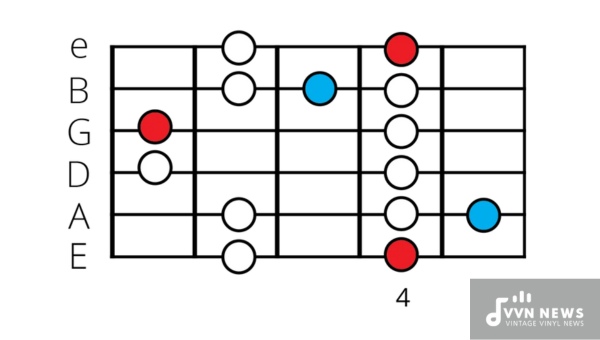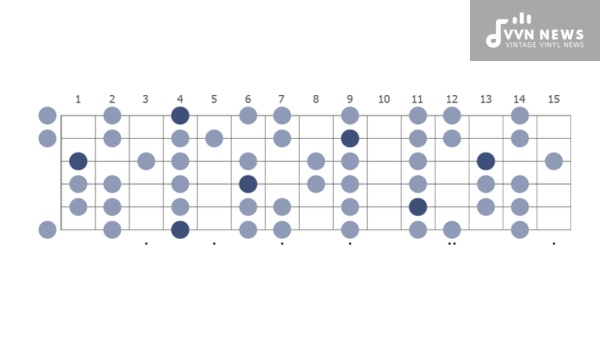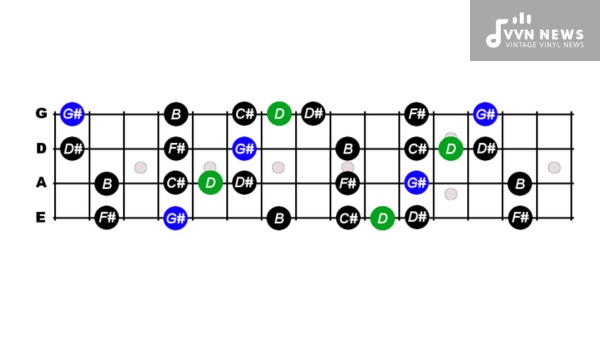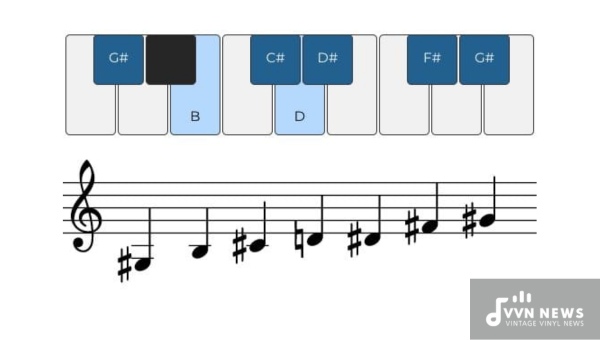As a musician or an aspiring guitarist, you’ve likely encountered various scales that add soul and depth to your playing.
One such scale that’s indispensable in the realm of blues, rock, and jazz is the “G minor blues scale.”
Known for its expressive quality and melodic versatility, this scale is a go-to tool for injecting that classic bluesy feel into your music.
Grasping its structure and learning how to use it can open up new avenues of creativity in your playing.
The G minor blues scale is more than just memorizing notes; it’s about feeling the music on a deeper level.
Whether you’re bending strings on an electric guitar or tickling the ivories on a piano, this scale has the power to convey emotions that resonate with listeners.
In this post, I’ll be sharing insights into how you can master the G minor blues scale to enhance your musical expression and connect with your audience through evocative improvisations and soulful solos.
What is the G Minor Blues Scale?
The G minor blues scale is a captivating six-note scale that musicians often use to add a moody, gritty flavor to their compositions.
It’s constructed from the following notes: G, Bb, C, C#, D, and F. This scale is essentially a G minor pentatonic scale (G, Bb, C, D, F) with the addition of a chromatic passing tone—the C#, also referred to as the “blue note.”
This gives the scale its signature melancholic yet edgy sound that’s synonymous with blues music.
Its unique tonal quality can evoke deep emotion and add intriguing tension within improvisation and melody lines.
How do you assemble the G Minor Blues Scale?

Assembling the G Minor Blues Scale begins with the foundational G minor pentatonic scale.
Start with the following notes: G (the root), Bb (the minor third), C (the perfect fourth), D (the perfect fifth), and F (the minor seventh).
These five notes give you a solid base—the skeleton of blues music.
Next, to transform this into the blues scale, you integrate the “blue note,” which is the augmented fourth/diminished fifth—in this case, C#.
This additional note infuses tension and that quintessential blues feel into your scale.
Here’s a step-by-step breakdown:
- Begin with the root note, G.
- Add in Bb; this is the minor third, essential for creating that somber, bluesy sound.
- Follow with C; the perfect fourth remains neutral yet pivotal for melody construction.
- Introduce C#; this is your critical “blue note”, serving as a bridge within your licks and riffs.
- Proceed to D; which acts as the perfect fifth, reinforcing the scale’s structure.
- Conclude with F; as the minor seventh, it accentuates the scale’s depth.
Commit these steps to memory and their musical role to effectively wield the power of the G Minor Blues Scale in your playing.
Also Read: 17 Best Patchbay For Studio & Live Audio [Organize Your Gear]
G Minor Blues Scale Shapes
The G minor blues scale can be navigated across the guitar’s fretboard through five distinct scale shapes.
Each shape provides a unique way to play the scale in different positions, allowing for versatile expression and the ability to slide seamlessly from one octave to another.
Shape 1: The Root Position
This is where most beginners start. Anchored around the root note on the 3rd fret of the 6th string (the low E string), this shape stretches from the 3rd to the 6th frets.
Your fingers will get accustomed to where that bluesy C# lies within reach for that quintessential blues flair.
Shape 2: The Box Pattern
Advancing up the neck, we find the box pattern typically starting around the 5th fret. Here, your root note G sits on the 5th string.
This compact shape is beloved for its ease of use during solos and is a staple in any blues guitarist’s repertoire.
Shape 3: The Stretch Out
Shape three spreads out your fingers as it traverses from roughly the 7th to 10th frets.
It gives you access to higher notes with that same mournful resonance, enabling more expressive playing.
Shape 4: Higher Octave Embrace
When you’re ready to take your soloing higher up on the neck, shape four comes into play around the 10th fret, giving a fresh sonic perspective by hitting an octave above your initial starting point.
Shape 5: The Full Neck Run
For those who like to employ their entire fretboard, this final pattern extends from around approximately 12th to 15th frets, offering another octave’s worth of emotion-laden notes.
Mastering these five shapes grants you fluidity and confidence across your instrument’s entire range.
Visualize each shape as a part of a larger roadmap; by learning them all, you’ll navigate through solos with ease and expressiveness.
Also Read: 19 Best Audio Interfaces For Home & Studio Recording 2025
What Separates the G Minor Blues Scale from Its Major Counterpart?

When comparing the G minor blues scale to its major counterpart, the G major blues scale, we start to see a stark contrast in mood and application.
The G major blues scale includes the notes G, A, Bb, B, D, and E. Whereas the minor scale conjures images of smoky bars and heartache, the major blues scale brings a brighter, more upbeat vibe.
A key difference lies in the third note of their respective scales: The G minor has a Bb (minor third) giving it a darker sound, while the G major contains a B (major third) that offers a happier tonal quality.
Furthermore, while both scales include a blue note adding tension, their placement differs—creating distinct sounds characteristic of each scale.
These differences mean that each scale has its own emotional voice:
- G Minor Blues: Reflects introspection and soul-searching.
- G Major Blues: Exudes optimism and resilience.
Musicians choose these scales based on the emotion they wish to convey within their music.
In blues progressions and solos, exchanging these scales can dramatically alter the mood.
Therefore, understanding when to use each is crucial for effective musical expression.
What Backing Tracks are Recommended for Mastering the G Minor Blues Scale?
When it comes to mastering the G minor blues scale, practicing with backing tracks is an effective strategy.
These tracks can help you solidify your understanding of how the scale fits within different musical contexts.
Here’s a list of recommended backing tracks, each providing a unique approach to honing your skills:
- 12-Bar Blues Progression in G minor: This classic progression is a staple in blues music. It allows you to explore the scale over a familiar structure, encouraging fluency and creativity. You can find such tracks labeled as “G Minor Blues Backing Track” on platforms like YouTube or Spotify.
- Slow Blues Backing Tracks: If you’re starting, slow blues tracks can give you the breathing room necessary to think about your note choices and experiment with phrasing. Search for “Slow G Minor Blues Backing Track” to get started.
- Funk Groove in G Minor: Funk grooves offer a rhythmic backdrop that challenges you to syncopate your melodies within tighter grooves. Find these by searching “Funk Groove Backing Track in G Minor.”
- Jazz Swing in G Minor: For an elevated challenge, jazz swing backing tracks push your improvisational skills with faster chord changes and non-traditional blues progressions—ideal for advanced players looking to expand their vocabulary.
Utilizing different types of backing tracks not only aids in mastering the G minor blues scale but also prepares you for live playing scenarios across various styles.
Make sure to play along with these tracks regularly, focusing on nailing the timing and articulation of each note within your solos for maximum impact.
Also Read: Haas Effect [The Powerful Tool To Upgrade Your Audio Mix]
Why is Auditory Training Crucial in Learning Scales Such as the G Minor Blues Scale?

As you delve into the world of music, developing your ear is just as important as honing your technical skills.
Auditory training, or ear training, is the process of learning to identify pitches, intervals, melody, chords, and rhythms by ear.
It’s a fundamental skill that can dramatically improve how you understand and utilize scales like the G Minor Blues Scale.
- Developing Musical Intuition: Training your ear helps you internalize the scale’s sounds, which cultivates a natural feel for when and how to use the G minor blues scale effectively within a piece. The more you listen, the better your intuition becomes.
- Improvisational Skills: Familiarity with the scale’s sound allows for spontaneous creativity. By knowing what each note should sound like, you can navigate through improvisations confidently and seamlessly integrate the scale into different musical contexts.
- Recognition of Tonal Relationships: Sound recognition isn’t just about single notes. You’ll begin to know how intervals within the G minor blues scale relate to one another, which is key for creating musical lines that flow logically.
- Expressive Playing: Emotion is at the heart of blues music. As you work on listening closely to variations in pitch and timbre, you’ll gain insights into how to deliver notes with feeling—transforming technical play into expressive communication.
- Memorization and Recall: Your muscle memory links up with auditory cues. The better your ear is trained, the quicker you can recall scales and translate them onto your instrument without having to reference sheet music or tablature.
- Transcription Skills: With a well-trained ear, picking out the G minor blues scale—or snippets of it—in songs becomes easier. This skill enhances your ability to learn new pieces by ear, an invaluable tool for any musician’s toolkit.
By honing this sensory skill set alongside technical practice, you will unlock a deeper dimension of musicianship that resonates powerfully within the realm of blues and beyond.
Songs that Utilize the G Minor Blues Scale
The evocative sounds of the G minor blues scale can be found across a myriad of genres, adding a touch of soul and introspection to any piece.
Here’s a look at some iconic songs that effectively incorporate this scale:
- “The Thrill is Gone” by B.B. King – This classic blues number is a textbook example of the emotive power of the G minor blues scale. The haunting solo sections exemplify how the ‘blue note’ adds depth and a sense of longing to King’s expressive guitar licks.
- “While My Guitar Gently Weeps” by The Beatles – George Harrison’s guitar solo in this song weaves through the G minor blues scale to create a sorrowful atmosphere, complementing the song’s themes of melancholy and loss.
- “Since I’ve Been Loving You” by Led Zeppelin – Jimmy Page’s use of bending and vibrato taps into the expressive core of the G minor blues scale, offering a compelling blend of rock’s edge with blues’ raw emotion.
Each song highlights distinct applications of the G minor blues scale, showcasing its versatility and emotional range.
Whether laying down gritty riffs or sculpting poignant melodies, this musical tool enriches compositions with its characteristic sound.
Also Read: 10 Tips For Soundproofing Your Subwoofer [Upgrade Your Audio Setup]
FAQ about the G Minor Blues Scale
What key is the G Minor Blues Scale in?
The G Minor Blues Scale is in the key of G minor.
Can I use the G Minor Blues Scale over major chords?
Yes, you can play the G minor blues scale over both major and minor chords for a bluesy effect.
Is it necessary to learn all five shapes of the G Minor Blues Scale?
To be versatile on your instrument, it’s beneficial to learn all five shapes for greater flexibility and creativity.
How can I practice effectively with the G Minor Blues Scale?
Practice by using backing tracks in G minor or by jamming with songs in that key to develop your improvisational skills.
Which famous songs feature the G Minor Blues Scale?
One notable example is B.B. King’s “The Thrill Is Gone,” which showcases the expressive power of this scale.
Conclusion
Mastering the G minor blues scale is a journey of deepening your musical vocabulary.
By incorporating this scale into your practice routine and creative explorations, you’re unlocking doors to expressive solos and rich improvisations.
Always remember to listen attentively to how blues masters utilize these scales—it’s by emulating their passion that you develop your unique sound.
With time and dedication, the G minor blues scale will become second nature, allowing your playing to convey the very essence of blues music effortlessly.
When you embrace the moody charm of the G minor blues scale, it transforms not only your music but also enriches the soulful expression of every note you play.








